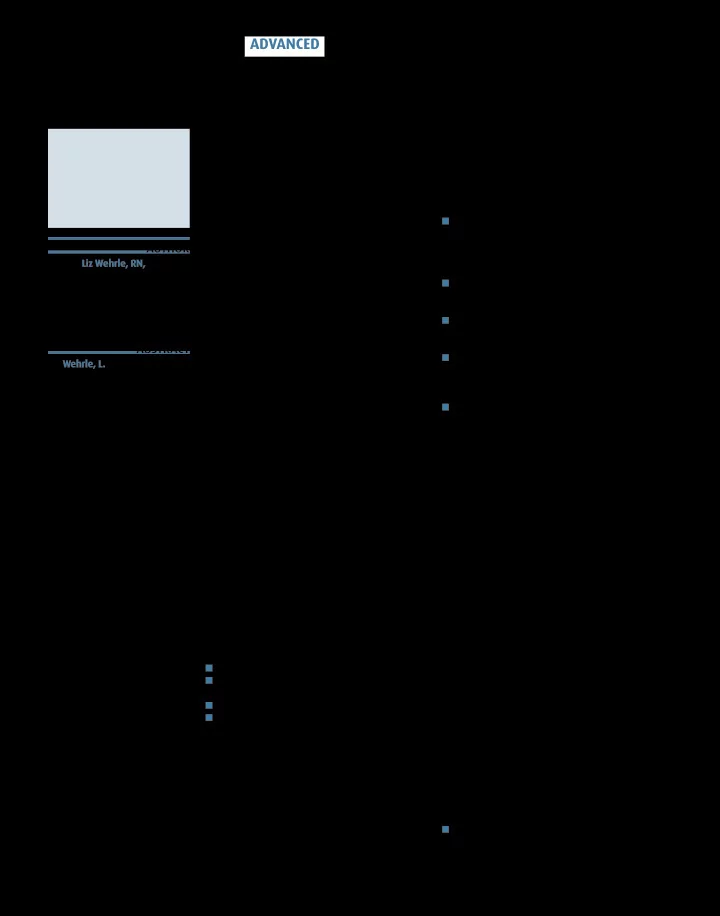

CLINICAL ADVANCED Epilepsy: its presentation and nursing management EACH year in the UK about 25,000 people develop epi- ■ These start as a simple partial seizure, but spread out SPL lepsy (Walker and Shorvon, 1999), making it the most of the localised area to include other areas of the brain, common serious neurological condition. Seizures are a although the activity is still confined to the hemisphere aUTHOR symptom of a disease (Sander and Hart, 1997a: 13), just of the brain where the activity originated – it does not Liz Wehrle, RN, is epilepsy as a sneeze may be a symptom of influenza, and they spread into the opposite hemisphere; specialist nurse and unit manager, may be the first indication that something is not right. ■ The patient appears blank, stares, and is unaware of the Sir William Gowers and the Sander and Hart (1997a: 14) describe an epileptic sei- his/her surroundings and may be unable to Queen Elizabeth Medical Centres, zure as: ‘a transient paroxysm of excessive or communicate verbally; National Society for Epilepsy, uncontrolled discharges of neurons which may be caused ■ In some patients there is posturing of the upper and Buckinghamshire. by a number of different aetiologies, leading to lower limbs, which may extend outwards, and the head epileptic seizures’. may turn to one side; aBSTRaCT The form a seizure takes depends on where in the ■ Patients who have no warning will fall to the floor if Wehrle, L. (2003) Epilepsy: its brain it starts and how far it spreads. Seizures must be they are standing. A phase of involuntary motor presentation and nursing recurrent for a diagnosis of epilepsy to be considered movements may follow of which the patient usually is management. Nursing Times ; (Russell and Wehrle, 1998). It is vital, therefore, that a totally unaware; 99: 20, 30–33. detailed history is obtained as soon as possible after the ■ Complex partial seizures last from a couple of minutes Nearly 25,000 people in the UK first seizure. to several days in a few extreme cases. develop epilepsy each year, A clearly documented medical history from the patient The involuntary movements (automatisms) may making it one of the most may speed up the introduction of a successful course of present differently in different patients. Some may have common serious neurological treatment. When taking a history it is crucial to ask the verbal automatisms, making noises, meaningless sounds, conditions. The form a seizure patient about any drugs currently being taken grunts, or whistling noises, others may clearly repeat takes depends on where it starts and whether these are prescribed, over-the-counter words or sentences. or recreational. Some patients may demonstrate ambulatory in the brain and how far it There are various types of epileptic seizure, and it is automatisms such as walking about the room or spreads. Nurses need to recognise important to recognise each one, as the management running very quickly when least expected. Oro- the different types of epileptic will vary according to the type. There are two main alimentary auto-matisms involve the oro-facial muscles, seizure and the appropriate categories – partial and generalised – with different types and include chewing movements, lip smacking, and nursing management of each. of seizure in each category. swallowing movements. National guidance on how Patients may show signs of fear or laughter, known as epilepsy services can be improved Partial seizures mimicry automatisms. Other automatisms cause patients will be published by the to fiddle with their hands, clothes, or objects in the room, These originate in one of the lobes of the brain. There are government and will include a or they may tap, pat or rub objects. This could become two types of partial seizure – simple and complex – and national service framework for serious if a patient were in an acute hospital ward near each manifests itself in the patient according to the part long-term conditions, including vital life-saving equipment. Some patients may start of the brain from which it originated. epilepsy. undressing or fiddling with themselves in the genital Simple partial seizures area. Violent automatisms can occur, but these are usually a result of the patient being acutely confused as ■ These originate in the lobes of the brain (see Fig. 1); a consequence of the seizure. Some patients become ■ Patients may say they are having an aura, or warning, violent if they are restrained. A person who is having a in this case it is an epigastric sensation; complex partial seizure is often mistaken by the public or ■ Consciousness is not impaired; emergency response teams as being drunk or having ■ Some patients report a tingling or numbing sensation, while others report flashing lights. taken drugs. Nursing management Nursing management Because some of the symptoms can be very frightening, Complex partial seizures can be difficult to manage. If the the nurse should stay with the patient and offer reassur- seizure starts as only a warning, nursing management ance that the seizure will pass. Because the simple should be the same as for simple partial seizures. partial seizure is a warning of a stronger seizure, the However, should the patient fall to the floor manage- nurse should assess the immediate environment to ment should be as follows: ensure that, should the patient fall, any potential hazards ■ Assess the patient for any signs of injury. Check also for are removed that could cause injury. limb displacement, as this may indicate the patient has Complex partial seizures a fracture; 30 30 NT 20 May 2003 Vol 99 No 20 www.nursingtimes.net
Recommend
More recommend